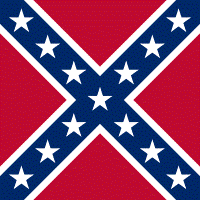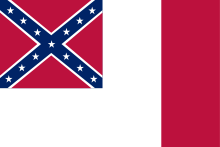
FGF E-Package
The Confederate Lawyer
July 29, 2010
The Conquered Banner
by Charles G. Mills
fitzgerald griffin foundation
 |
 |
 |
 |
| First national flag with 7 stars (4 Mar 1861 - 21 May 1861) |
First national flag with 9 stars (21 May 1861 - 2 Jul 1861) |
First national flag with 11
stars (2 Jul 1861 - 28 Nov 1861) |
First national flag with 13
stars (28 Nov 1861 - 26 May 1863) |
 |
 |
 |
| The Battle Flag of the Confederacy | The Second Confederate Navy Jack 1863-1865 |
Third National flag, "The Blood Stained
Banner" (since 4 Mar 1865) |
GLEN COVE, NY — A campaign of hatred and vilification of the Confederate flag is underway on the grounds that the flag does not conform to 21st-century standards of racial equality.
The flag in question was never actually a national flag of the Confederacy. It was officially designated as the flag of regiments of the Confederate States Army and called the “Battle Flag.” Ironically, after a protracted battle to get the Battle Flag removed from the state flag of Georgia, Georgia finally adopted a new flag. This new flag, which was acceptable to the haters of the Confederate flag, was closely modeled on the first flag of the Confederacy, the Stars and Bars. Most people in the North do not know that the Stars and Bars is a Confederate flag; they think that the Stars and Bars is just another nickname for the Battle Flag. The Confederate Navy used a jack almost identical to the Battle Flag.
Recent Georgia Flags Of all the Confederate flags, the one Southerners love most is the Battle Flag, precisely because it is the one under which their ancestors fought and died for Southern freedom.
We are constantly told that symbols are important, and rightly so. The fact that certain people despise the flag under which young men fought and died for Southern independence but have no problem with the official flags of the Confederate government is a symbol of the evil that lurks in their hearts. They hate the symbol of the army in which black men and white men fought together to protect their homes and home states; they do not even recognize the three national flags of the Confederate government that tried unsuccessfully to prevent blacks from fighting for the South.
Immediately after the Northern victory, Father Abram Joseph Ryan, a Confederate Catholic chaplain, wrote a poem called “The Conquered Banner.” In the third stanza, he expresses the spirit of the Confederate Army:
Furl that banner! furl it sadly!
Once ten thousands hailed it gladly.
And ten thousands wildly, madly,
Swore it should forever wave;
Swore that foeman's sword should never
Hearts like theirs entwined dissever,
Till that flag should float forever
O'er their freedom or their grave!This is an important point. The Confederate Army was fighting for freedom, not against freedom. The Confederate Army was not fighting for slavery, states’ rights, low tariffs, or the Constitution. It was fighting to protect its homes from an invader.
The poem ends on a pessimistic and solemn note about the death of people and the death of hope.
Furl that banner, softly, slowly!
Treat it gently--it is holy--
For it droops above the dead.
Touch it not--unfold it never,
Let it droop there, furled forever,
For its people's hopes are dead.
Immediately before that, however, is a tribute to hope:
Furl that Banner! True, 'tis gory,
Yet 'tis wreathed around with glory,
And 'twill live in song and story,
Though its folds are in the dust;
For its fame on brightest pages,
Penned by poets and by sages,
Shall go sounding down the ages--
Furl its folds though now we must.The poem contains a tribute to those who weep for those who fell before the Banner and a pardon for those who mistreated it. It would be 12 years, however, and after Northern aid to the South during a cholera epidemic, before Father Ryan wrote a poem called “Requiem for the Federal Dead.” Not all those who lived in the North were enemies of the South. Many languished in military jails because they opposed the war. In 1866, the people of New York City fought a five-day battle against the Northern Army. Father Ryan, no doubt, needed time before he would mourn those who had killed the soldiers to whom he was ministering on the battlefield. If, however, he could be reconciled to the Northern Army, should not the North be reconciled to the Southern Army and its purely military flag?
The Confederate Lawyer archives
The Confederate Lawyer column is copyright © 2010 by Charles G. Mills and the Fitzgerald Griffin Foundation, www.fgfBooks.com. All rights reserved.
Charles G. Mills is the Judge Advocate or general counsel for the New York State American Legion. He has forty years of experience in many trial and appellate courts and has published several articles about the law.
See his biographical sketch and additional columns here.
To sponsor the FGF E-Package, please send a tax-deductible donation to the:
Fitzgerald Griffin Foundation
344 Maple Avenue West, #281
Vienna, VA 22180
1-877-726-0058
publishing@fgfbooks.com
or donate online.
@ 2025 Fitzgerald Griffin Foundation
